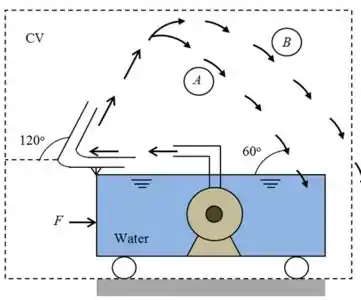pump in a tank of water at 208C directs a jet at 45 ft/s and
200 gal/min against a vane, as shown in Fig. P3.73. Compute the force F to hold the cart stationary if the jet follows
(a) path A or (b) path B. The tank holds 550 gal of water at
this instant.
Passo 1
Saaaalve, tranquilo? Vamos lá resolver mais uma questão juntos?! 😊
Desenhando o volume de controle para o tanque de água

Passo 2
(a) Se o jato seguir o caminho , não há fluxo de momento cruzando o volume de controle.
Portanto, o fluxo de momento zero resulta em força zero para manter o carrinho estacionário.
Portanto, a força para manter o carrinho parado se o caminho do jato seguir é 0.
Passo 3
(b) Se o jato seguir o caminho , haverá um fluxo de momento atravessando o volume de controle, o que resulta na força para manter o carrinho parado.
Escreva a equação de momento ao longo da direção horizontal.
Aqui, a taxa de fluxo de massa da água é e o componente horizontal da velocidade para o caminho é
Passo 4
Calcule a taxa de fluxo de massa da água.
Aqui, a densidade da água é e a taxa de fluxo da água é .
Passo 5
Calcular o componente horizontal da velocidade para o caminho .
Aqui, a velocidade do jato é .
Substituindo valores
Portanto, a força para manter o carrinho parado para o caminho é .
Resposta
a) 0
b)